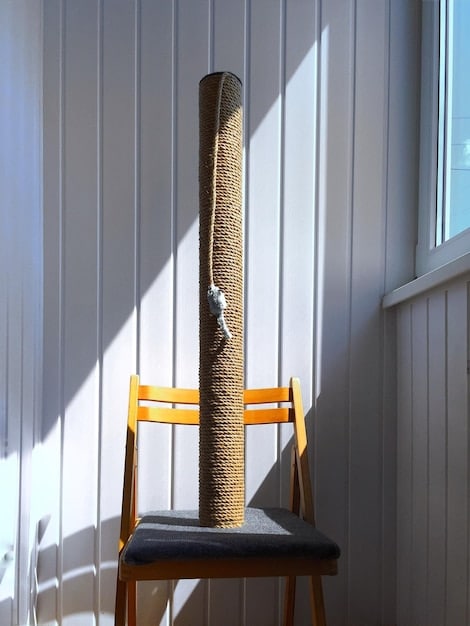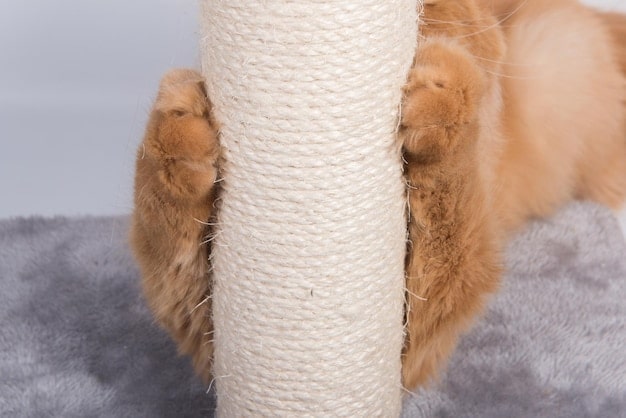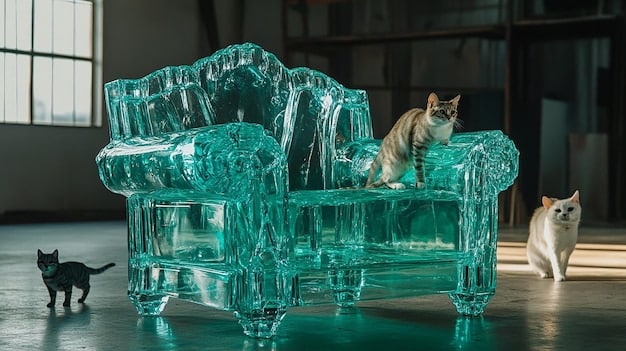Train Your Cat to Use a Scratching Post: Save Your Furniture!

Training your cat to use a scratching post is crucial for protecting your furniture by redirecting their natural scratching instincts to a more appropriate and designated area.
Is your furniture bearing the brunt of your cat’s scratching habits? Learn how to train your cat to use a scratching post and save your furniture with these simple and effective methods.
Understanding Why Cats Scratch
Scratching is a natural and essential behavior for cats. Understanding why cats scratch is the first step in redirecting this behavior towards a scratching post.
Cats scratch for several reasons. Primarily, it helps them to maintain their claws by removing the dead outer layer. Additionally, scratching serves as a form of exercise, allowing cats to stretch their muscles and tendons. But it’s not just physical; scratching is also a way for cats to mark their territory, both visually through the shredded material and chemically through scent glands in their paws.
The Benefits of Scratching
Providing scratching posts isn’t just about saving your furniture; it’s about fulfilling your cat’s innate needs. Here’s why scratching is so important for cats:
- Claw Maintenance: Scratching helps cats keep their claws healthy and sharp, essential for climbing and self-defense.
- Physical Exercise: The act of scratching stretches a cat’s body, providing a good workout for their muscles.
- Territorial Marking: Cats leave their scent through scratching, marking the area as their own.
Knowing these reasons can help you empathize with your cat’s need to scratch, making it easier to guide them toward appropriate scratching surfaces.
Understanding these motivations can help you choose the right type of scratching post and placement, making it more appealing for your cat to use.
Choosing the Right Scratching Post
Selecting the right scratching post is crucial for encouraging your cat to use it. A scratching post that doesn’t appeal to your cat will likely be ignored, leaving your furniture vulnerable.
The ideal scratching post should be sturdy, tall enough for your cat to fully stretch, and covered in a material that mimics natural scratching surfaces. Sisal fabric is a popular choice because it’s durable and provides a satisfying texture for cats to dig their claws into. Cardboard scratchers are also a hit, especially those that offer different angles and textures.
Types of Scratching Posts
- Vertical Posts: Ideal for cats who like to stretch tall while scratching.
- Horizontal Scratchers: Suitable for cats who prefer scratching on the ground.
- Angled Scratchers: A good compromise, allowing cats to scratch at different angles.
Consider your cat’s preferences and the space you have available when selecting a scratching post. Experiment with different types until you find one that your cat loves.

The key to choosing the right scratching post relies on knowing what your cat enjoys. Observation is critical in this endeavor!
Strategic Placement of Scratching Posts
Where you place your scratching post is just as important as the type of post you choose. Strategic placement increases the likelihood that your cat will use the post instead of your furniture.
Place scratching posts in areas where your cat already likes to scratch or near their favorite sleeping spots. Cats often scratch after waking up, so having a post nearby can encourage them to use it right away. High-traffic areas are also good choices, as scratching is a way for cats to mark their territory.
Tips for Placement
- Near Furniture: Initially, place the scratching post near the furniture your cat is scratching.
- High-Traffic Areas: Areas where your cat spends a lot of time.
- Multiple Locations: Having more than one scratching post increases the chances of your cat using them.
If your cat is already scratching a specific piece of furniture, try placing the scratching post directly in front of it. Once your cat starts using the post consistently, you can gradually move it to a more convenient location.
The location should be part of your cat’s normal, everyday environment.
Enticing Your Cat to Use the Scratching Post
Getting your cat interested in the scratching post might require a little coaxing. There are several methods you can use to entice your cat to use the new scratching area.
One popular method is to use catnip. Sprinkle catnip on or around the scratching post to attract your cat and encourage them to investigate it. Another approach is to use interactive play. Dangle a toy near the scratching post to entice your cat to reach for it and accidentally scratch the post. You can also try physically guiding your cat’s paws onto the post to show them how it works, but be gentle and avoid forcing them.
Methods to Attract Your Cat
Discover different ways to create a positive association between your cat and the new scratching post.
- Catnip: Sprinkle catnip on the post to attract your cat.
- Interactive Play: Use toys to entice your cat to scratch the post.
- Positive Reinforcement: Reward your cat with treats and praise when they use the post.
Be patient and persistent. It may take some time for your cat to fully accept the scratching post as their go-to scratching spot.
Remember that every cat has their own preferences and timelines.
Discouraging Scratching on Furniture
Alongside encouraging your cat to use the scratching post, it’s important to discourage them from scratching your furniture. This involves making the furniture less appealing as a scratching surface.
One effective method is to use deterrents such as double-sided tape or plastic covers on furniture. Cats dislike the sticky feel of the tape and the smooth texture of the plastic, making them less likely to scratch those surfaces. Scent deterrents, such as citrus-scented sprays, can also be effective, as cats generally dislike strong citrus smells. Regularly trim your cat’s nails to minimize damage if they do scratch the furniture. Never punish your cat for scratching furniture, as this can create fear and anxiety, leading to other behavioral issues.
Effective Deterrents
Discover multiple deterrents and how they work in creating undesirable areas for cats. Below are ways of making your furniture less desirable:
- Double-Sided Tape: Cats dislike the sticky texture.
- Plastic Covers: Provides an unappealing surface for scratching.
- Scent Deterrents: Citrus or other scents that cats dislike.
Consistency is key when discouraging scratching on furniture. Be persistent with your chosen deterrents, and always provide an alternative scratching outlet in the form of a scratching post.

Deterrents are a crucial part of the transformation to redirect the cat to the appropriate place to scratch.
Maintaining the Scratching Post
Keeping the scratching post in good condition will help ensure your cat continues to use it. Regular maintenance can also prolong the life of the post.
Replace the scratching post when it becomes too worn or damaged. Cats prefer scratching surfaces that have some texture, so a completely smooth or frayed post may not be as appealing. Clean the area around the scratching post regularly to remove any shed fur or debris that may deter your cat from using it. If you’ve used catnip, reapply it periodically to keep the post enticing.
Scratching Post Maintenance Checklist
Follow these tips to extend the life of the scratching post, and keep your cat satisfied:
- Regular Cleaning: Remove shed fur and debris.
- Catnip Refresh: Reapply catnip to keep the post enticing.
- Replacement: Replace the post when it becomes too worn.
By keeping the scratching post in good condition, you’re prioritizing your cat’s scratching needs and protecting your furniture at the same time.
When a scratching post is maintained, it ensures that the cat likes to visit the area.
| Key Point | Brief Description |
|---|---|
| 🐾 Understanding Scratching | Scratching is natural for claw maintenance, exercise, and marking territory. |
| ✅ Choosing the Right Post | Select sturdy, tall posts with sisal or cardboard that cats love. |
| 📍 Strategic Placement | Place posts near sleeping areas or where cats already scratch. |
| 🚫 Discouraging Furniture Scratching | Use deterrents like tape or sprays and always provide alternatives. |
Frequently Asked Questions
▼
Cats scratch to maintain their claws, stretch their muscles, and mark their territory. It’s a natural and essential behavior.
▼
Sisal fabric and cardboard scratchers are popular because they mimic natural scratching surfaces. Vertical posts are good for stretching, while horizontal scratchers suit ground-scratchers.
▼
Place it near your cat’s sleeping areas or where they already scratch. High-traffic areas are also good as scratching for marking territory and visibility.
▼
Use catnip or toys to entice your cat. You can also gently guide their paws onto the post and give a treat.
▼
Use deterrents like double-sided tape, plastic covers, or citrus sprays. Always provide an alternative scratching post and reward your cat for using it.
Conclusion
By understanding your cat’s scratching needs, choosing the right scratching post, and employing positive reinforcement techniques, you can successfully redirect their scratching behavior and protect your furniture. Consistency, patience, and a little bit of catnip can go a long way in creating a harmonious environment for both you and your feline friend.





